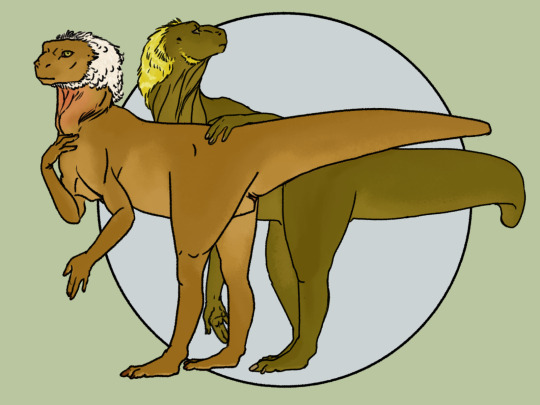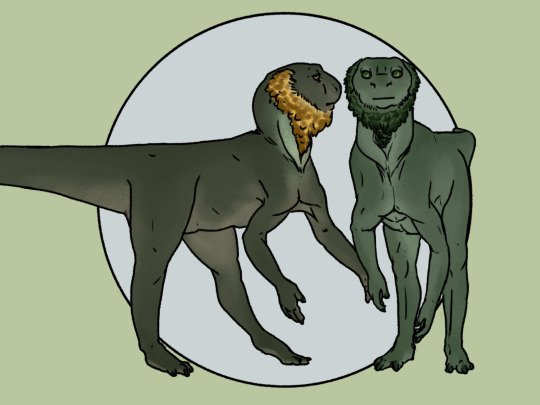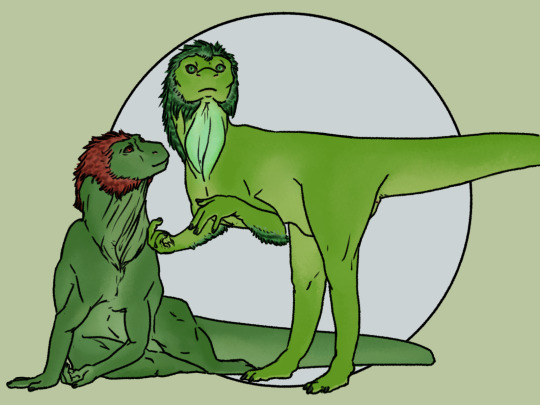#axuega
Explore tagged Tumblr posts
Text

The founding populations of Uanlikri
Drawn by the sight of the moon over the horizon, antioles have peopled Uanlikri times and times again, first as newcomers to an empty land, and eventually as conquerors and colonizers. Which lineage first set foot on Uanlikri is a matter of debate: by the time of the first written histories, three of them were already so established as to form clines of ancestry from one end of the continent to the other.
Jẽ
The Jẽ might have been the first to set foot on the continent. They arrived from the north, through the belt of archipelagoes that almost connect Uanlikri to the land now known as Axue. It is a matter of debate to which extent the Jẽ actually form a single ancestry - how many times people arrived from the North, settled in, and mingled with those already there and those that followed. It is common to divide the Jẽ between the olive skinned coastal Ki peoples, and the brown skinned Cã desert-dwellers. The Cã count among their ancestors the civilization that invented the first forms of writing on Uanlikri. For this reason, they are often treated by scholars as descendents of Uanlikri's primordial culture - it is likely, however, that their arrival to Uanlikri is a latter one.
Illustrated: Cã male with brown skin and white feathers and Ki female with olive skin and yellow feathers.

Kpikigd
It is unknown when the Kpikigd arrived, but it is know that they stayed south for a long time before spreading northwards. The Kpikigd reached Uanlikri from the other side of the world by crossing the ice cap around the South Pole - a hazardous journey which resulted in a very small founder population. The Kpikigd that survived were a skewed sample of the population in their land of origin. Kpikigd are short and stout, with thick limbs and short rounded faces. The Kpikigd founders were hypermelanistic, black of skin and feather alike. In time, the Kpikigd expanded northwards, meeting and mingling with the southward-bound Undeno - the majority of Kpikigd today have significant Undeno contribution to their lineage, and the black skin and feathers of the founders are an unusual set of traits which survives today in the most isolated southern populations. Kpikigd have dark, greyish skin and tend to have abundant striping on their feathers.
Illustrated: Male with yellow feathers, female with green feathers, both of majority kpikigd ancestry with some distant Undeno contribution.

Undeno
The Undeno are two: the First Undeno, and the Second Undeno. Both arrived to Uanlikri from the distant lands to the West. It is unknow how the First Undeno crossed the ocean to reach Uanlikri, and when they did so exactly - it is only know that they did so a long time ago. The genetically distinct Undeno pigmies - the Dongo and the Apina'at - point towards a very early arrival.
The First Undeno landed on the Western Peninsula and spread eastward inland, and south and northwards along the western coast. In the millennia between their arrival and the first written histories of the Cã, they had settled the center of the continent and mingled with the Kpikigd and Jẽ so as to form a cline of ancestries, from the Kpikigd-most in the South to the Jẽ-most in the North, with the Undeno in the middle.
The Second Undeno arrived in recent history, bathing the Western Peninsula in fire and blood. They arrived as the conquering colonists of a distant empire, and were left behind as their homeland turned its gaze inwards again. Millennia have created considerable distance between the First and Second Undeno, but a shared ancestry remained apparent to the peoples of Uanlikri, as beyond the green skin, both groups share an ancient and deeply held taboo against showing one's throat, the roots of which are lost to time.
Illustrated: Female of the Second Undeno with red feathers, male of the First Undeno with green feathers. Arm feathers are a rare trait found in some central populations of the First Undeno.

Axuega
The Axuega are the last arrived on Uanlikri. They began coming to Uanlikri long after the first written words, from Axue, the same land the Jẽ had come from. By then, the continent was brimming with antioles, and there were no empty footholds. In any case, the Axuega did not come as conquerors and settlers, but as traders. Even so, some Axuega settled, and some more are settling still, leaving their old lives behind and founding a new one on Uanlikri. They are numerous enough to form diasporas in some regions, but not so much as to seem a serious threat to the locals... Yet.
Axuega are unusually tall, lanky, and pale, with low feather coverage and novel blue and blueish feathers.
Illustrated: Axuega male with green skin and blue feathers, and Axuega female with beige skin and teal feathers.

#long post#antiole world#worldbuilding#antioles#uanlikri#jẽ#je#ki#cã#undeno#undenau#axuega#axue#kpikigd#art by me#speculative evolution#speculative biology#note on pronunciation: cã is pronounced like the french word “chant” (t is silent) and jẽ has the same vowel as the french word “fin”
114 notes
·
View notes